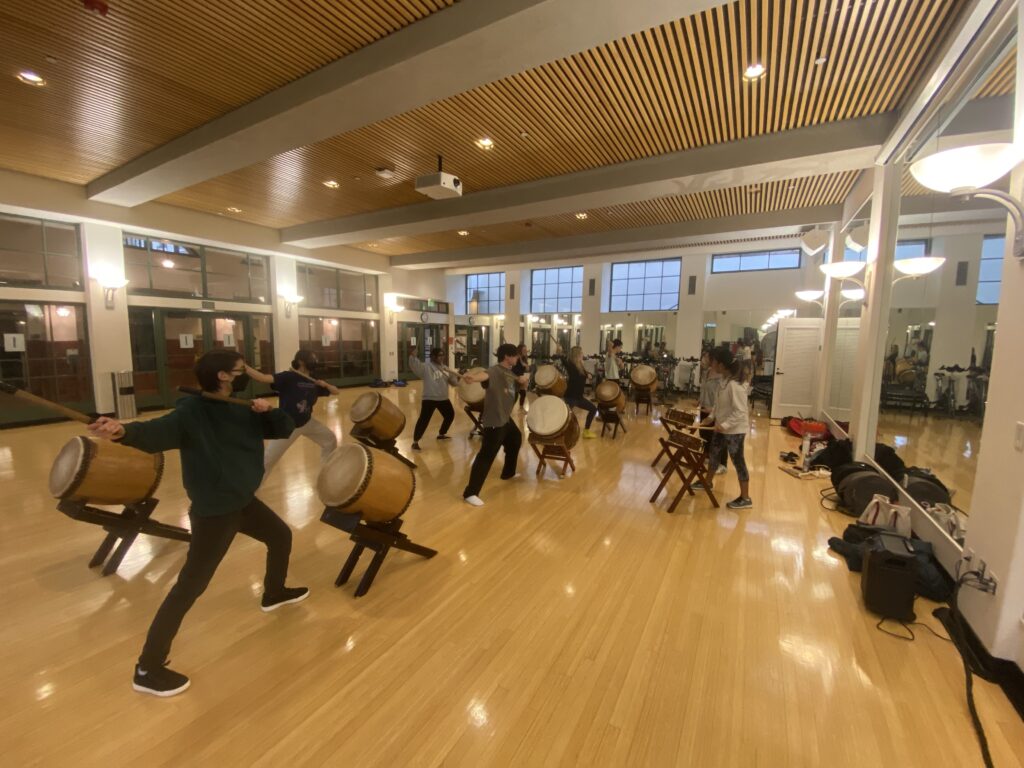Belen Yudess ’25
Social Media Manager
If you have ever walked by the Tiernan Field House on a sunny Sunday afternoon, you have most likely heard the rhythmic yet powerful beats of the Claremont Taiko Drumming Club. Named Shogo Taiko, the club meets on a weekly basis.
Shogo Taiko was established in 2004 and was running strong until club activity was paused at the beginning of the COVID-19 pandemic. Now, after its return during the 2021-22 school year, the club is ready to publicly perform and carry on its impressive legacy for future generations.
Taiko drumming is a Japanese form of drumming that includes martial arts, dance, and music all in one. It originally came from China and then its influence spread to Japan where it became a larger art form and was modified.
It was originally used to signal the start of harvest and bring in good luck and celebrate festivals. That’s where the large percussive sounds that you would expect at these fun occasions comes from. They would play on the fields and such, but nowadays that’s not the case.
There are three types of taiko drums: the smaller shime daiko which keeps the beat, the medium-sized chu daiko which are used by performers to play the main song, and the mounted o daiko with a deeper and more powerful sound.
Club Co-President Medha Gelli ’23 noted that teaching taiko follows a traditional, yet innovative, method. “It is definitely learned and created in a unique way,” she said. “What we do is learn pieces that have been passed down from previous generations of our group in an oral tradition called coho, which literally means mouth talk.”
As a part of this tradition, beats are orally communicated before they are executed. “That’s how older members teach the younger members and that’s part of the tradition of Shogo Taiko,” Gelli said. “We’ve been teaching our new members Hachi Jo, which is our traditional piece for the newbies to learn in their first semester.”
Gelli’s history with taiko stems back much further than her beginning with the 5C club. It’s been a large part of her life, even acting as a topic for her college application essays.
After being introduced to the art at the age of 9, Gelli jumped at the opportunity to join a group. “I loved the sound and the movement and the loud drums,” she said. “I signed up and the group was really great! My sensai was really amazing and she definitely grew my passion for taiko.”
Gelli has found that taiko has played an important role in connecting her with other cultures and acting as an escape from everyday stresses. “I think the sense of community and the group energizing or adrenaline is something I have never experienced outside of the group,” she said. “If anyone has that one thing you do that helps you forget about all your worries, this is that for me.”
Taiko is made of three components: the physical, the beat, and the sound itself. Movement plays an essential role –– posture and positioning of hands come right after mastery of rhythm.
“If you’re supposed to be doing a certain movement you have to be intentional about it, and you also want to be in sync with your group mates,” said Gelli. “I think another thing that we teach is that crescendos come from not only playing the drum harder, but moving your hands bigger to create more momentum to get those louder movements.”
Kii, the third element, is composed of encouraging sounds made throughout the song to support fellow drummers. These sounds also serve to keep the team on track as they perform.
Gelli is enjoying and learning a lot through her role as Co-President, but she also explains the slightly difficult process of juggling the managerial aspects of her position as well as teaching taiko to students with some to no prior knowledge.
“Our senior members who graduated last year were able to teach me how to learn songs, conduct practice, answer emails, budget concerns; things that presidents should be able to do,” she said. “We didn’t get a lot of time to transition leadership from last year though, so there’s definitely things our leadership team is dealing with right now.”
Tasks that have not happened in years, such as buying uniforms, are areas Gelli finds the most difficult. “I’ve been learning as I go, and I’m trying to provide the best experience I can,” she said. As she looks towards the future, she hopes to draw from practices held by previous leadership to guide the team.
“I want to prioritize more individual support, which is everyone works on their own thing and other people come around and correct or help them,” she said. “Taiko requires a lot of feedback in terms of continually correcting and there’s always room to improve.”
That being said, Gelli has already seen a lot of improvement. She is excited about the future of the club as she watches her fellow performers advance.
“Seeing the students from last year who used to be new students, I’ve definitely seen them grow,” she said. “That was my first year as part of leadership so now they’re having to figure out how they learn things and teach them to someone else.”
The Claremont Taiko Drumming Club is scheduled to perform Feb. 18 at 12 p.m. on the Scripps Lawn for Family Weekend and March 30 at 7 p.m. at Big Bridges Auditorium for the Benton Museum’s exhibit, “5 Indices of a Tortured Body” by Wardell Milon.
Image Source: Belen Yudess ’25



